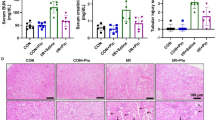Abstract
Aim
It has been reported that tumor necrosis factor (TNF)-α plays dual controversial roles, beneficial or detrimental, in the pathogenesis of murine lupus nephritis (LN). However, its precise role in the development of human LN remains to be determined.
Methods
We examine the effect of pretreatment with TNF-α on the toll-like receptor 3 (TLR3) signaling induced by polyinosinic-polycytidylic acid (poly IC), a synthetic analog of viral dsRNA that makes “pseudoviral” infection in cultured normal human mesangial cells, and analyzed the expression of CC chemokine ligand 5 (CCL5) via TLR3/interferon (IFN)-β/retinoic acid-inducible gene-I (RIG-I) pathway by reverse transcriptase-polymerase chain reaction, Western blotting and enzyme-linked immunosorbent assay.
Results
We found synergistic effect of TNF-α, even at low level, on the expression of CCL5 induced by poly IC in a concentration-dependent manner, in comparison with that by poly IC alone. Knockdown of either IFN-β or RIG-I decreased CCL5 expression induced by TNF-α followed by poly IC.
Conclusion
Pretreatment with TNF-α leads marked activation of the TLR3/IFN-β/RIG-I/CCL5 axis induced by “pseudoviral” infection. Since chronic local activation of proinflammatory cytokines including TNF-α in resident renal cells may exist in patients with active lupus, synergistic effect of TNF-α and “pseudoviral” infection is possibly involved in the development of LN.




Similar content being viewed by others
References
Koenig KF, Groeschl I, Pesickova SS, Tesar V, Eisenberger U, Trendelenburg M. Serum cytokine profile in patients with active lupus nephritis. Cytokine. 2012;60:410–6.
Yap DYH, Lai KN. The role of cytokines in the pathogenesis of systemic lupus erythematosus—from bench to bedside. Nephrology (Carlton). 2013;18:243–55.
Yung S, Cheung KF, Zhang Q, Chan TM. Mediators of inflammation and their effect on resident renal cells: Implications in lupus nephritis. Clin Dev Immunol. 2013;2013:317682.
Aringer M, Houssiau F, Gordon C, et al. Adverse events and efficacy of TNF-α blockade with infliximab in patients with systemic lupus erythematosus: long-term follow-up of 13 patients. Rheumatology (Oxford). 2009;48:1451–4.
Lai AS, Lai KN. Viral nephropathy. Nat Clin Pract Nephrol. 2006;2:254–62.
Anders HJ. Pseudoviral immunity—a novel concept for lupus. Trends Mol Med. 2009;15:553–61.
Migliorini A, Ebid R, Scherbaum CR, Anders HJ. The danger control concept in kidney disease: mesangial cells. J Nephrol. 2013;26:437–49.
Imaizumi T, Tanaka H, Matsumiya T, et al. Retinoic acid-inducible gene-I is induced by double-stranded RNA and regulates the expression of CC chemokine ligand (CCL) 5 in human mesangial cells. Nephrol Dial Transpl. 2010;25:3534–9.
Imaizumi T, Aizawa-Yashiro T, Tsuruga K, et al. Melanoma differentiation- associated gene 5 regulates the expression of a chemokine CXCL10 in human mesangial cells: implications for chronic inflammatory renal diseases. Tohoku J Exp Med. 2012;228:17–26.
Aizawa-Yashiro T, Imaizumi T, Tsuruga K, et al. Glomerular expression of fractalkine is induced by polyinosinic-polycytidylic acid in human mesangial cells: possible involvement of fractalkine after viral infection. Pediatr Res. 2013;73:180–6.
Tanaka H, Imaizumi T. Inflammatory chemokine expression via Toll-like receptor 3 signaling in normal human mesangial cells. Clin Dev Immunol. 2013;2013:984708.
Watanabe S, Imaizumi T, Tsuruga K, et al. Glomerular expression of myxovirus resistance protein 1 (Mx1) in human mesangial cells: possible activation of innate immunity in the pathogenesis of lupus nephritis. Nephrology (Carlton). 2013;18:833–7.
Suzuki K, Imaizumi T, Oki E, Tsugawa K, Ito E, Tanaka H. Expression of retinoic acid-inducible gene-I in lupus nephritis. Nephrol Dial Transpl. 2007;22:2407–9.
Chan RW, Lai FM, Li EK, et al. Messenger RNA expression of RANTES in the urinary sediment of patients with lupus nephritis. Nephrology (Carlton). 2006;11:219–25.
Patole PS, Pawar RD, Lech M, et al. Expression and regulation of Toll-like receptors in lupus-like immune complex glomerulonephritis of MRL-Fas (lpr) mice. Nephrol Dial Transpl. 2006;21:3062–73.
Robson MG. Toll-like receptors and renal disease. Nephron Exp Nephrol. 2009;113:e1–7.
Yoneyama M, Kikuchi M, Matsumoto K, et al. Shared and unique functions of the DExD/H-box helicases RIG-I, MDA5 and LGP2 in antiviral innate immunity. J Immunol. 2005;175:2851–8.
Satriano JA, Bana B, Luckow B, Nelson P, Schlondorff DO. Regulation of RANTES and ICAM-1 expression in murine mesangial cells. J Am Soc Nephrol. 1997;8:596–603.
Krensky AM, Ahn YT. Mechanisms of disease: regulation of RANTES (CCL5) in renal disease. Nat Clin Pract Nephrol. 2007;3:164–70.
Wolf G, Aberle S, Thaiss F, et al. TNF-α induces expression of the chemoattractant cytokine RANTES in cultured mouse mesangial cells. Kidney Int. 1993;44:795–804.
Anders HJ, Lichtnekert J, Allam R. Interferon-α and -β in kidney inflammation. Kidney Int. 2010;77:848–54.
Acknowledgments
This work was supported by grants-in-aid for Science from the Ministry of Education, Culture, Sports, Science and Technology of Japan (T. I. and H. T.), and by Grant for Hirosaki University Institutional Research (T. I.) and a Priority Research Grant for Young Scientists Designated by the President of Hirosaki University (T. M.). The authors thank A. Yamamoto, K. Nakata, A. Ono and K. Munakata for assistance.
Conflict of interest
No conflict of interest to declare.
Author information
Authors and Affiliations
Corresponding author
About this article
Cite this article
Imaizumi, T., Aizawa, T., Hayakari, R. et al. Tumor necrosis factor-α synergistically enhances polyinosinic-polycytidylic acid-induced toll-like receptor 3 signaling in cultured normal human mesangial cells: possible involvement in the pathogenesis of lupus nephritis. Clin Exp Nephrol 19, 75–81 (2015). https://doi.org/10.1007/s10157-014-0956-3
Received:
Accepted:
Published:
Issue Date:
DOI: https://doi.org/10.1007/s10157-014-0956-3




